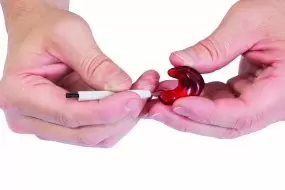Managing Earwax
 Let's start by saying that earwax is a good thing. That's right... earwax, or cerumen, is normal and even healthy for your ears. In average amounts, cerumen acts as a protective barrier to keep out infection, dust/dirt, and even foreign objects. A lack of earwax can lead to dry and itchy ears that are more vulnerable to infections such as "swimmer's ear." But as is often the case, too much of a good thing can be, well, not good.
Let's start by saying that earwax is a good thing. That's right... earwax, or cerumen, is normal and even healthy for your ears. In average amounts, cerumen acts as a protective barrier to keep out infection, dust/dirt, and even foreign objects. A lack of earwax can lead to dry and itchy ears that are more vulnerable to infections such as "swimmer's ear." But as is often the case, too much of a good thing can be, well, not good.
For most of us, our outer ears are self-cleaning. Both old skin and earwax typically migrate slowly out the earcanal opening and are discarded. Sometimes, however, earwax can get trapped, and even impacted. Although not well understood, certain people tend to produce more earwax than others. It's also a normal part of the aging process for earwax to become drier and harder, increasing the likelihood of impaction.
An overabundance of earwax can lead to discomfort, tinnitus (ringing in the ears), a feeling of fullness in the ears, and even hearing loss. Although there is no evidence that wearing hearing protection increases the occurrence of wax impactions, excessive earwax or other outer ear problems can certainly interfere with the comfortable use of earplugs. When necessary, a worker in high noise may need to wear earmuffs instead of earplugs until medical clearance is received.
Tips for maintaining healthy earcanals:
- Remember your earcanals are generally self-cleaning. As needed, use a damp washcloth only in the outer part of the ear.
- Do not attempt to clean your ears with cotton swabs or other objects such as pencils and keys; this will only push earwax further down into the ear and may result in impacted wax and scratches to the earcanal, leaving you vulnerable to infections.
- See your doctor if you routinely have earwax build-up or experience pain, tinnitus, hearing loss, or a feeling of fullness in your ears.
- With your physician's guidance, if needed, consider routine home treatments such as mineral oil, glycerin, or commercially available earwax softening kits. Do not attempt "ear candling," which is generally considered ineffective and could result in injury.
- Routinely wipe down hearing protectors or electronic earsets after use and clear sound tubes of any excess earwax.
To learn more about cerumen and ear care, check out these helpful resources:
Medline Plus, National Institutes of Health. Earwax.
American Academy of Otolaryngology. Earwax blockage and care.
CavCom SoundBytes. Aging and the Earcanal.
CavCom SoundBytes. Swimmer's Ear.
CONTACT CAVCOM to request an Earset Care Kit and educational materials about caring for your hearing protectors and electronics.
| Categories: | Hearing & Hearing Loss, Non-Occupational/General Interest |






